Fins multiple ways to solve Math problems. Choose the best and easy way to solve your math problems present on Go Math Text Book. Every student’s first preference to practice maths is Go Math Grade 8 Answer Key Chapter 9 Transformations and Congruence. Go Math Grade 8 Chapter 9 Transformations and Congruence Answer Key along with different explanations makes students’ math practice easy and simple. Refer to Go Math Grade 8 Answer Key to learn maths.
Go Math Grade 8 Answer Key Chapter 9 Transformations and Congruence
As many ways of problem-solving methods available on Go Math Grade 8 Chapter 9 Transformations and Congruence Solution Key, student’s can select the easy solving method and learn the method of solving math problems. Also, images included for a better understanding of the student. Therefore, students who want to score good marks in the exam must practice with Go Math Grade 8 Answer Key Chapter 9 Transformations and Congruence.
Lesson 1: Properties of Translations
- Properties of Translations – Page No. 282
- Properties of Translations – Page No. 283
- Properties of Translations Lesson Check – Page No. 284
Lesson 2: Properties of Reflections
- Properties of Reflections – Page No. 288
- Properties of Reflections – Page No. 289
- Properties of Reflections Lesson Check – Page No. 290
- Properties of Reflections Lesson Check 1 – Page No. 294
- Properties of Reflections Lesson Check 2 – Page No. 295
- Properties of Reflections Lesson Check 3 – Page No. 296
Lesson 3: Algebraic Representations of Transformations
- Algebraic Representations of Transformations – Page No. 300
- Algebraic Representations of Transformations – Page No. 301
- Algebraic Representations of Transformations Lesson Check – Page No. 302
Lesson 4: Congruent Figures
- Congruent Figures – Page No. 306
- Congruent Figures – Page No. 307
- Congruent Figures Lesson Check – Page No. 308
Model Quiz
Mixed Review
Guided Practice – Properties of Translations – Page No. 282
Question 1.
Vocabulary A __________________is a change in the position, size, or shape of a figure.
____________
Answer:
transformation
Explanation:
A transformation is a change in the position, size, or shape of a figure.
Question 2.
Vocabulary When you perform a transformation of a figure on the coordinate plane, the input of the transformation is called the ________________, and the output of the transformation is called the_________________ .
Type below:
____________
Answer:
pre-image
image
Explanation:
When you perform a transformation of a figure on the coordinate plane, the input of the transformation is called the pre-image, and the output of the transformation is called the image.
Question 3.
Joni translates a right triangle 2 units down and 4 units to the right. How does the orientation of the image of the triangle compare with the orientation of the preimage?
Orientation is: _______
Answer:
Orientation is: Same
Explanation:
Since translation does not change the shape and size of a geometric figure, the two triangles are identical in shape and size, so they are congruent and the orientation is the same
Question 4.
Rashid drew rectangle PQRS on a coordinate plane. He then translated the rectangle 3 units up and 3 units to the left and labeled the image P ‘Q ‘R ‘S ‘. How do rectangle PQRS and rectangle P ‘Q ‘R ‘S ‘ compare?
They are: _______
Answer:
congruent
Explanation:
Since translation does not change the shape and size of a geometric figure, the two rectangles are identical in shape and size, so they are congruent.
Question 5.
The figure shows trapezoid WXYZ. Graph the image of the trapezoid after a translation of 4 units up and 2 units to the left.

Type below:
____________
Answer:
After translation:
W'(-4, 3)
X'(2, 3)
Y'(1, 1)
Z'(-3, 1)
ESSENTIAL QUESTION CHECK-IN
Question 6.
What are the properties of translations?
Type below:
____________
Answer:
-> a translation is a geometric transformation that moves every point of a figure or space by the same amount in a given direction.
-> So the figures are identical and are congruent.
9.1 Independent Practice – Properties of Translations – Page No. 283
Question 7.
The figure shows triangle DEF.

a. Graph the image of the triangle after the translation that maps point D to point D ‘.
Type below:
____________
Answer:
2 left, and 4 down
Question 7.
b. How would you describe the translation?
Type below:
____________
Answer:
It has the same size, shape. and orientation, but a different location
Question 7.
c. How does the image of triangle DEF compare with the preimage?
____________
Answer:
congruent
Question 8.
a. Graph quadrilateral KLMN with vertices K(-3, 2), L(2, 2), M(0, -3), and N(-4, 0) on the coordinate grid.

Type below:
____________
Question 8.
b. On the same coordinate grid, graph the image of quadrilateral KLMN after a translation of 3 units to the right and 4 units up.
Type below:
____________
Answer:

Question 8.
c. Which side of the image is congruent to side \(\overline { LM } \)?
___________
Name three other pairs of congruent sides.
___________
Type below:
____________
Answer:
Line LM is congruent to Line L!M!
Line KL is equal to K’L’
Line MN is equal to M’N’
Line KN is equal to K’N’
Draw the image of the figure after each translation.
Question 9.
4 units left and 2 units down

Type below:
____________
Answer:
After translation
P'(-3, 1)
Q'(0, 2)
R'(0, -1)
S'(-3, -3)
Question 10.
5 units right and 3 units up

Type below:
____________
Answer:
After translation
A'(0, 4)
B'(3, 5)
C'(3, 1)
D'(0, 0)
Properties of Translations – Page No. 284
Question 11.
The figure shows the ascent of a hot air balloon. How would you describe the translation?

Type below:
____________
Answer:
4 units along positive X and 5 units along positive Y
Explanation:
Initial coordinate of balloon = ( -2 , -4)
Final coordinates of the balloon = (2,1)
Translation along x axis = 2 – (-2)
= 4 units along positive x direction
Translation along y axis = 1-(-4)
= 5 units along the positive y direction
Question 12.
Critical Thinking Is it possible that the orientation of a figure could change after it is translated? Explain.
_________
Answer:
No, it is not possible to change the orientation just by translation. As translation means, a transformation in which a figure is moved to another location without any change in size or orientation.
FOCUS ON HIGHER ORDER THINKING
Question 13.
a. Multistep Graph triangle XYZ with vertices X(-2, -5), Y(2, -2), and Z(4, -4) on the coordinate grid.

Question 13.
b. On the same coordinate grid, graph and label triangle X’Y’Z’, the image of triangle XYZ after a translation of 3 units to the left and 6 units up.
Question 13.
c. Now graph and label triangle X”Y”Z”, the image of triangle X’Y’Z’ after a translation of 1 unit to the left and 2 units down.
Type below:
____________
Answer:

Question 13.
d. Analyze Relationships How would you describe the translation that maps triangle XYZ onto triangle X”Y”Z”?
Type below:
____________
Answer:
Triangle XYZ has translated 4 units up and 4 units to the left
Question 14.
Critical Thinking The figure shows rectangle P’Q’R’S’, the image of rectangle PQRS after a translation of 5 units to the right and 7 units up. Graph and label the preimage PQRS.

Type below:
____________
Answer:

Question 15.
Communicate Mathematical Ideas Explain why the image of a figure after a translation is congruent to its preimage.
Type below:
____________
Answer:
A translation is a geometric transformation that moves every point of a figure or space by the same amount in a given direction. So the 2 figures are identical and the translated figure is congruent to its pre-image.
Guided Practice – Properties of Reflections – Page No. 288
Question 1.
Vocabulary A reflection is a transformation that flips a figure across a line called the __________ .
____________
Answer:
Reflection Axis
Explanation:
A reflection is a transformation that flips a figure across a line called the Reflection Axis.
Question 2.
The figure shows trapezoid ABCD.
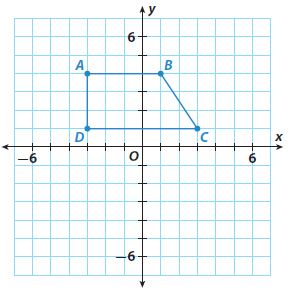
a. Graph the image of the trapezoid after a reflection across the x-axis. Label the vertices of the image.
Type below:
____________
Answer:
A'(-3, -4)
B'(1, -4)
C'(3, -1)
D'(-3, -1)
Question 2.
b. How do trapezoid ABCD and trapezoid A’B’C’D’ compare?
____________
Answer:
congruent
Explanation:
trapezoid ABCD and trapezoid A’B’C’D’ are congruent
Question 2.
c. What If? Suppose you reflected trapezoid ABCD across the y-axis. How would the orientation of the image of the trapezoid compare with the orientation of the preimage?
Type below:
____________
Answer:
The orientation would be reversed horizontally.
ESSENTIAL QUESTION CHECK-IN
Question 3.
What are the properties of reflections?
Type below:
____________
Answer:
properties of reflections
-> the size stays the same
-> the shape stays the same
-> the orientation does NOT stay the same
9.2 Independent Practice – Properties of Reflections – Page No. 289
The graph shows four right triangles. Use the graph for Exercises 4-7.

Question 4.
Which two triangles are reflections of each other across the x-axis?
Type below:
____________
Answer:
Triangles A and C are the reflections of each other across the x-axis.
Question 5.
For which two triangles is the line of reflection the y-axis?
Type below:
____________
Answer:
For triangle C & D the line of reflection is y-axis.
Question 6.
Which triangle is a translation of triangle C? How would you describe the translation?
Type below:
____________
Answer:
Triangle B is the translation of triangle C.
Lets take any one point of the triangle = (-2, -6)
Lets take the corresponding side of triangle B = (4,2)
Translation across x axis = 4 -(-2) = 6 units
Translation across y axis = 2 -(-6) = 8 units
Question 7.
Which triangles are congruent? How do you know?
Type below:
____________
Answer:
All the 4 triangles A, B, C, D are congruent.
The length of base and height of all the four triangles are 3 units, 4 units respectively.
Explanation:
All the 4 triangles A, B, C, D are congruent.
If base and height are equal then the hypotenuse should also be equal. Thus all three sides of the triangles A,B,C,D are equal. Thus these triangles are congruent,
The length of base and height of all the four triangles are 3 units, 4 units respectively.
Question 8.
a. Graph quadrilateral WXYZ with vertices W(-2, -2), X(3, 1), Y(5, -1), and Z(4, -6) on the coordinate grid.
Type below:
____________
Question 8.
b. On the same coordinate grid, graph quadrilateral W’X’Y’Z’, the image of quadrilateral WXYZ after a reflection across the x-axis.
Type below:
____________
Answer:

Question 8.
c. Which side of the image is congruent to side \(\overline { YZ } \)?
_______________
Name three other pairs of congruent sides.
_______________
Type below:
____________
Answer:
Line YZ = Line Y’Z’
Line WX = Line W’X’
Line XY = Line X’Y’
Line WZ = Line W’Z’
Question 8.
d. Which angle of the image is congruent to ∠X?
_______________
Name three other pairs of congruent angles.
_______________
Type below:
____________
Answer:
Angle X’
Angle W and Angle W’
Angle Y and Angle Y’
Angle Z and Angle Z’
Properties of Reflections – Page No. 290
Question 9.
Critical Thinking Is it possible that the image of a point after a reflection could be the same point as the preimage? Explain.
________
Answer:
Yes
Explanation:
It is possible that the image of a point after a reflection could be the same point as the preimage
FOCUS ON HIGHER ORDER THINKING
Question 10.
a. Graph the image of the figure shown after a reflection across the y-axis.

Type below:
____________
Answer:

Question 10.
b. On the same coordinate grid, graph the image of the figure you drew in part a after a reflection across the x-axis.
Type below:
____________
Answer:

Question 10.
c. Make a Conjecture What other sequence of transformations would produce the same final image from the original preimage? Check your answer by performing the transformations. Then make a conjecture that generalizes your findings.
Type below:
____________
Answer:
The same image can be obtained by reflecting first across the x-axis and then across the y-axis.
Reflecting a figure first across the y-axis and then across the x-axis has the same outcome,. reflecting first across the x-axis and then across the y-axis.
Question 11.
a. Graph triangle DEF with vertices D(2, 6), E(5, 6), and F(5, 1) on the coordinate grid.
Question 11.
b. Next graph triangle D ′E ′F ′, the image of triangle DEF after a reflection across the y-axis.
Type below:
____________
Question 11.
c. On the same coordinate grid, graph triangle D′′ E′′ F′′, the image of triangle D ′E ′F ′ after a translation of 7 units down and 2 units to the right.
Type below:
____________
Answer:

Question 11.
d. Analyze Relationships Find a different sequence of transformations that will transform triangle DEF to triangle D ′′E ′′F ′′.
Type below:
____________
Answer:
Translate triangle DEF 7 units down and 2 units to the left. Then reflect the image across the y-axis.
Guided Practice – Properties of Reflections – Page No. 294
Question 1.
Vocabulary A rotation is a transformation that turns a figure around a given _____ called the center of rotation.
____________
Answer:
point
Explanation:
A rotation is a transformation that turns a figure around a given point called the center of rotation.
Siobhan rotates a right triangle 90° counterclockwise about the origin.
Question 2.
How does the orientation of the image of the triangle compare with the orientation of the preimage?
Type below:
____________
Answer:
Each leg in the preimage is perpendicular to its corresponding leg in the image.
Question 3.
Is the image of the triangle congruent to the preimage?
______
Answer:
Yes
Explanation:
The image of the triangle is congruent to the preimage
Draw the image of the figure after the given rotation about the origin.
Question 4.
90° counterclockwise

Type below:
____________
Answer:

Question 5.
180°

Type below:
____________
Answer:
After 180° rotation
A'(-2, -3)
B'(-4, -1)
C'(-2, 0)
D'(0, -1)
ESSENTIAL QUESTION CHECK-IN
Question 6.
What are the properties of rotations?
Type below:
____________
Answer:
Rotations preserve size and shape but change orientation.
9.3 Independent Practice – Properties of Reflections – Page No. 295
Question 7.
The figure shows triangle ABC and a rotation of the triangle about the origin.

a. How would you describe the rotation?
____________
Answer:
ABC was rotated 90º counterclockwise about the origin
Question 7.
b. What are the coordinates of the image?
Type below:
____________
Answer:
A'(3, 1)
B'(2, 3)
C'(-1, 4)
Question 8.
The graph shows a figure and its image after a transformation.
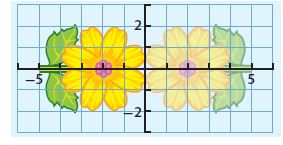
a. How would you describe this as a rotation?
____________
Answer:
The figure was rotated 180º about the origin.
Question 8.
b. Can you describe this as a transformation other than a rotation? Explain.
____________
Answer:
Yes
Explanation:
This can also be described as a reflection across the y-axis.
Question 9.
What type of rotation will preserve the orientation of the H-shaped figure in the grid?

____________
Answer:
A 180º rotation about the origin will preserve the orientation of the H-shaped figure in the grid.
Question 10.
A point with coordinates (-2, -3) is rotated 90° clockwise about the origin. What are the coordinates of its image?
(_______ , _______)
Answer:
(-3, 2)
Explanation:
The new coordinates are (-3, 2)
Complete the table with rotations of 180° or 90°. Include the direction of rotation for rotations of 90°.
Question 11.

Type below:
____________
Answer:

Properties of Reflections – Page No. 296
Draw the image of the figure after the given rotation about the origin.
Question 14.
180°

Type below:
____________
Answer:
After 180°
A'(4, 0)
B'(2, -1)
C'(0, 0)
D'(2, 1)
Question 15.
270° counterclockwise

Type below:
____________
Answer:
After 270º counterclockwise rotation
A'(1, 2)
B'(2, -1)
C'(4, 2)
Question 16.
Is there a rotation for which the orientation of the image is always the same as that of the preimage? If so, what?
______
Answer:
Yes
Explanation:
A 360º rotation will always be the same as the original image
FOCUS ON HIGHER ORDER THINKING
Question 17.
Problem Solving Lucas is playing a game where he has to rotate a figure for it to fit in an open space. Every time he clicks a button, the figure rotates 90 degrees clockwise. How many times does he need to click the button so that each figure returns to its original orientation?
Figure A ____________
Figure B ____________
Figure C ____________
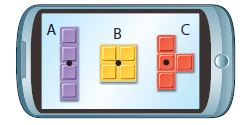
Figure A: _________ time(s)
Figure B: _________ time(s)
Figure C: _________ time(s)
Answer:
Figure A: 2 time(s)
Figure B: 1 time(s)
Figure C: 4 time(s)
Explanation:
2 times to return to original orientation
1 time to return to original orientation
4 times to return to original orientation
Question 18.
Make a Conjecture Triangle ABC is reflected across the y-axis to form the image A′B′C′. Triangle A′B′C′ is then reflected across the x-axis to form the image A″B″C″. What type of rotation can be used to describe the relationship between triangle A″B″C″ and triangle ABC?
Type below:
____________
Answer:
Triangle A’B’C’ is a 90º rotation of triangle ABC
Triangle A”B”C” is a 90º rotation of triangle A’B’C’
Therefore, Triangle A”B”C” is a 180º rotation of triangle ABC
Question 19.
Communicate Mathematical Ideas Point A is on the y-axis. Describe all possible locations of image A′ for rotations of 90°, 180°, and 270°. Include the origin as a possible location for A.
Type below:
____________
Answer:
If Point A is on the y-axis, Point A’ will be on the x-axis for 190° and 270° rotations and on the y-axis for 180° rotation
If point A is at the origin,
A’ is at the origin for any rotation about the origin.
Guided Practice – Algebraic Representations of Transformations – Page No. 300
Question 1.
Triangle XYZ has vertices X(-3, -2), Y(-1, 0), and Z(1, -6). Find the vertices of triangle X′Y′Z′ after a translation of 6 units to the right. Then graph the triangle and its image.
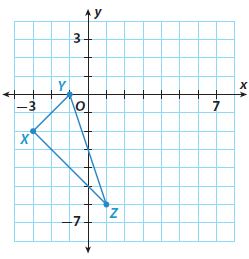
Type below:
____________
Answer:
After a translation of 6 units to the right:
X'(3, -2)
Y'(5, 0)
Z'(7, -6)
Question 2.
Describe what happens to the x- and y-coordinates after a point is reflected across the x-axis.
Type below:
____________
Answer:
The x-coordinate remains the same, while the sign of the y-coordinate changes
Question 3.
Use the rule (x, y) → (y, -x) to graph the image of the triangle at right. Then describe the transformation.
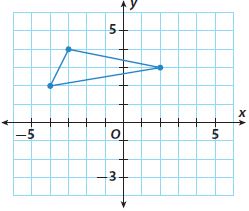
Type below:
____________
Answer:
The triangle is rotated 90º clockwise about the origin
ESSENTIAL QUESTION CHECK-IN
Question 4.
How do the x- and y-coordinates change when a figure is translated right a units and down b units?
Type below:
____________
Answer:
The x-coordinates increase by a, and the y-coordinates decrease by b
9.4 Independent Practice – Algebraic Representations of Transformations – Page No. 301
Write an algebraic rule to describe each transformation.Then describe the transformation.
Question 5.

Type below:
____________
Answer:
algebraic rule
(x, y) -> (x-2, y-5)
transformation
translation of 2 units to the left and 5 units down
new coordinates
M'(-4, -2)
N'(-2, -2)
O'(-1, -4)
P'(-4, -4)
Question 6.

Type below:
____________
Answer:
algebraic rule
(x, y) -> (-x, -y)
transformation
rotation of 180º
new coordinates
A'(0, 0)
B'(0, -3)
C'(2, -3)
D'(2, 0)
Question 7.
Triangle XYZ has vertices X(6, -2.3), Y(7.5, 5), and Z(8, 4). When translated, X′ has coordinates (2.8, -1.3). Write a rule to describe this transformation. Then find the coordinates of Y′ and Z′.
Type below:
____________
Answer:
algebraic rule
(x, y) -> (x-3.2, y+1)
new coordinates
Y'(4.3, 6)
Z'(4.8, 5)
Question 8.
Point L has coordinates (3, -5). The coordinates of point L′ after a reflection are (-3, -5). Without graphing, tell which axis point L was reflected across. Explain your answer.
____________
Answer:
Point L was reflected on the y-axis.
When you reflect a point across the y-axis, the sign of the x-coordinate changes, and the sign of the y-coordinate remains the same
Question 9.
Use the rule (x, y) → (x – 2, y – 4) to graph the image of the rectangle. Then describe the transformation.

Type below:
____________
Answer:
The rectangle is translated 2 units to the left and 4 units down
Question 10.
Parallelogram ABCD has vertices A(−2, −5\(\frac{1}{2}\)), B(−4, −5\(\frac{1}{2}\)),C(-3, -2), and D(-1, -2). Find the vertices of parallelogram A′B′C′D′ after a translation of 2 \(\frac{1}{2}\) units down.
Type below:
__________
Answer:
after a translation of 2 \(\frac{1}{2}\) units
A'(-2, -8)
B'(-4, -8)
C'(-3, -4 \(\frac{1}{2}\))
D'(-1, -4 \(\frac{1}{2}\))
Algebraic Representations of Transformations – Page No. 302
Question 11.
Alexandra drew the logo shown on half-inch graph paper. Write a rule that describes the translation Alexandra used to create the shadow on the letter A.
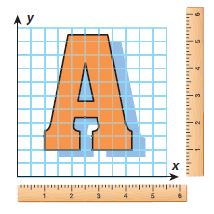
Type below:
__________
Answer:
(x,y) –> (x+1,y-0.5)
(x+1,y-0.5) –> (x+0.5,y-0.25)
Explanation:
translation in units
(x,y) –> (x+1,y-0.5)
This step converts translation rule in units to translation rule in inches. (Divide by 2 since graph paper is half inch paper.
(x+1,y-0.5) –> (x+0.5,y-0.25)
Question 12.
Kite KLMN has vertices at K(1, 3), L(2, 4), M(3, 3), and N(2, 0). After the kite is rotated, K′ has coordinates (-3, 1). Describe the rotation, and include a rule in your description. Then find the coordinates of L′, M′, and N′.
Type below:
__________
Answer:
rotation
90 counterclockwise
rule
(x, y) -> (-y, x)
new coordinates
L'(-4, 2)
M'(-3, 3)
N'(0, 2)
FOCUS ON HIGHER ORDER THINKING
Question 13.
Make a Conjecture Graph the triangle with vertices (-3, 4), (3, 4), and (-5, -5). Use the transformation (y, x) to graph its image.
a. Which vertex of the image has the same coordinates as a vertex of the original figure? Explain why this is true.

Type below:
__________
Answer:
(-5, 5) has the same coordinates
Question 13.
b. What is the equation of a line through the origin and this point?
Type below:
__________
Answer:
x and y are equal so switching x and y has no effect on the coordinates
Question 13.
c. Describe the transformation of the triangle.
Type below:
__________
Answer:
x and y are equal so switching x and y has no effect on the coordinates
Question 14.
Critical Thinking Mitchell says the point (0, 0) does not change when reflected across the x- or y-axis or when rotated about the origin. Do you agree with Mitchell? Explain why or why not.
_______
Answer:
Yes, I agree with Mitchell
Explanation:
Reflecting across the x-axis or y-axis changes the sign of the y or x coordinate 0 cannot change signs.
Rotating about the origin does not change the origin (0, 0)
Question 15.
Analyze Relationships Triangle ABC with vertices A(-2, -2), B(-3, 1), and C(1, 1) is translated by (x, y) → (x – 1, y + 3). Then the image, triangle A′B′C′, is translated by (x, y) → (x + 4, y – 1), resulting in A″B″C″.
a. Find the coordinates for the vertices of triangle A″B″C″.
Type below:
__________
Answer:
A”(-2-1+4, -2+3-1) = A”(1, 0)
B”(-3-1+4, 1+3-1) = B”(0, 3)
C”(1-1+4, 1+3-1) = C”(4, 3)
Question 15.
b. Write a rule for one translation that maps triangle ABC to triangle A″B″C″.
Type below:
__________
Answer:
(x, y) -> (x-1+4, y+3-1)
(x, y) -> (x+3, y+2)
Guided Practice – Congruent Figures – Page No. 306
Question 1.
Apply the indicated series of transformations to the rectangle. Each transformation is applied to the image of the previous transformation, not the original figure. Label each image with the letter of the transformation applied.

A. Reflection across the y-axis
B. Rotation 90° clockwise around the origin
C. (x, y) → (x – 2, y)
D. Rotation 90° counterclockwise around the origin
E. (x, y) → (x – 7, y – 2)
Type below:
__________
Answer:
A. After transformation
(1, 3)
(1, 4)
(4, 4)
(4, 3)
B. After transformation
(3, -1)
(4, -1)
(4, -4)
(3, -4)
C. After transformation
(1, -1)
(2, -1)
(2, -4)
(1, -4)
D. After transformation
(1, 1)
(1, 2)
(4, 2)
(4, 1)
E. After transformation
(-6, -1)
(-6, 0)
(-3, 0)
(-3, -1)
Identify a sequence of transformations that will transform figure A into figure C.

Question 2.
What transformation is used to transform figure A into figure B?
Type below:
__________
Answer:
Reflection across the y-axis
Explanation:
Reflection across the y-axis is used to transform figure A into figure B
Question 3.
What transformation is used to transform figure B into figure C?
Type below:
__________
Answer:
Translation 3 units right and 4 units down
Explanation:
Translation 3 units right and 4 units down is used to transform figure B into figure C
Question 4.
What sequence of transformations is used to transform figure A into figure C? Express the transformations algebraically.
Type below:
__________
Answer:
Reflection across the y-axis is used to transform figure A into figure B
Translation 3 units right and 4 units down is used to transform figure B into figure C
Algebraically:
(x, y) -> (-x, y)
(x, y) -> (x +3, y-4)
Question 5.
Vocabulary What does it mean for two figures to be congruent?
Type below:
__________
Answer:
Two figures are congruent when the figures have the same size and the same shape.
ESSENTIAL QUESTION CHECK-IN
Question 6.
After a sequence of translations, reflections, and rotations, what is true about the first figure and the final figure?
Type below:
__________
Answer:
After a sequence of translations, reflections, and rotations, the first and final figures have the same size and shape. (They are congruent)
9.5 Independent Practice – Congruent Figures – Page No. 307
For each given figure A, graph figures B and C using the given sequence of transformations. State whether figures A and C have the same or different orientation.
Question 7.

Figure B: a translation of 1 unit to the right and 3 units up
Figure C: a 90° clockwise rotation around the origin
Type below:
__________
Answer:
Different orientation
Explanation:
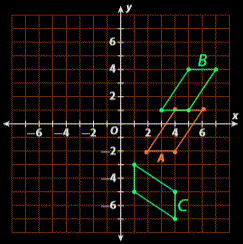
Different orientation
Question 8.

Figure B: a reflection across the y-axis
Figure C: a 180° rotation around the origin
Type below:
__________
Answer:
Different orientation
Explanation:

Different orientation
Question 9.

Figure B: a reflection across the y-axis
Figure C: a translation 2 units down
Type below:
__________
Answer:
Different orientation
Explanation:

Different orientation
Question 10.

Figure B: a translation 2 units up
Figure C: a rotation of 180° around the origin
Type below:
__________
Answer:
Different orientation
Explanation:

Different orientation
Congruent Figures – Page No. 308
Question 11.
Represent Real-World Problems A city planner wanted to place the new town library at site A. The mayor thought that it would be better at site B. What transformations were applied to the building at site A to relocate the building to site B? Did the mayor change the size or orientation of the library?

Type below:
__________
Answer:
From Site A to Site B: Translation 2 units right and 4 units down
The size did NOT change
The orientation changed
Question 12.
Persevere in Problem Solving Find a sequence of three transformations that can be used to obtain figure D from figure A. Graph the figures B and C that are created by the transformations.
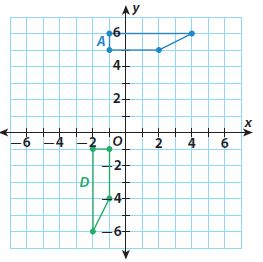
Type below:
__________
Answer:
From figure A to D:
Reflection across the x-axis (-1, -5) (-1, -6) (2, -5) (4, -6)
90º clockwise rotation (4, -1) (5, -1) (5, -4) (4, -6)
translation 6 units left (4, -1) (5, -1) (5, -4) (4, -6)
FOCUS ON HIGHER ORDER THINKING
Question 13.
Counterexamples The Commutative Properties for Addition and Multiplication state that the order of two numbers being added or multiplied does not change the sum or product. Are translations and rotations commutative? If not, give a counterexample.
________
Answer:
No, Translation and rotations are not commutative
Explanation:
The point (2, 2) becomes (2, -4) when translated 2 units to the right then rotated 90 around the origin.
The point (2, 2) becomes (4, -2) when rotated 90 around the origin then translated 2 units to the right.
The above two points are not the same.
Question 14.
Multiple Representations For each representation, describe a possible sequence of transformations.
a. (x, y) → (-x – 2, y + 1)
Type below:
____________
Answer:
translation 2 units right and 1 unit up
reflection across y-axis
Question 14.
b. (x, y) → (y, -x – 3)
Type below:
____________
Answer:
rotation 90º clockwise around the origin
translation 3 units down
Ready to Go On? – Model Quiz – Page No. 309
9.1–9.3 Properties of Translations, Reflections, and Rotations
Question 1.
Graph the image of triangle ABC after a translation of 6 units to the right and 4 units down. Label the vertices of the image A’, B’, and C’.

Type below:
____________
Answer:
After translation:
A'(2, 1)
B'(2, -1)
C'(5, -1)
Question 2.
On the same coordinate grid, graph the image of triangle ABC after a reflection across the x-axis. Label the vertices of the image A”, B”, and C”.
Type below:
____________
Answer:
After reflection:
A”(-4, -5)
B”(-4, -3)
C”(-1, -3)
Question 3.
Graph the image of HIJK after it is rotated 180° about the origin. Label the vertices of the image H’I’J’K’.

Type below:
____________
Answer:
After rotation:
H'(0, -4)
I'(0, -1)
J'(2, -2)
K'(2, -3)
9.4 Algebraic Representations of Transformations
Question 4.
A triangle has vertices at (2, 3), (−2, 2), and (−3, 5). What are the coordinates of the vertices of the image after the translation (x, y) → (x + 4, y − 3)?
Type below:
____________
Answer:
After translation:
(6, 0)
(2, -1)
(1, 2)
9.5 Congruent Figures
Question 5.
Vocabulary Translations, reflections, and rotations produce a figure that is _____ to the original figure.
Type below:
____________
Answer:
congruent
Explanation:
Vocabulary Translations, reflections, and rotations produce a figure that is congruent to the original figure.
Question 6.
Use the coordinate grid for Exercise 3. Reflect H’I’J’K’ over the y-axis, then rotate it 180° about the origin. Label the new figure H″I″J″K″.
Type below:
____________
Answer:
after reflection
H'(0, -4)
I'(0, -1)
J'(-2, -2)
K'(-2, -3)
after rotation
H”(0, 4)
I”(0, 1)
J”(2, 2)
K”(2, 3)
ESSENTIAL QUESTION
Question 7.
How can you use transformations to solve real-world problems?
Type below:
____________
Answer:
Transformational properties allow the systematic movement of congruent figures while maintaining or adjusting their orientation.
Selected Response – Mixed Review – Page No. 310
Question 1.
What would be the orientation of the figure L after a translation of 8 units to the right and 3 units up?
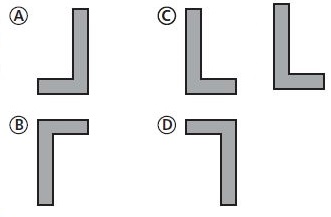
Options:
a. A
b. B
c. C
d. D
Answer:
c. C
Explanation:
After a translation of 8 units right and 3 units up, the orientation of figure L stays the same.
Question 2.
Figure A is reflected over the y-axis and then lowered 6 units. Which sequence describes these transformations?
Options:
a. (x, y) -> (x, -y) and (x, y) -> (x, y – 6)
b. (x, y) -> (-x, y) and (x, y) -> (x, y – 6)
c. (x, y) -> (x, -y) and (x, y) -> (x – 6, y)
d. (x, y) -> (-x, y) and (x, y) -> (x – 6, y)
Answer:
b. (x, y) -> (-x, y) and (x, y) -> (x, y – 6)
Explanation:
reflection over y-axis:
(x, y) -> (-x, y)
Translation 6 units down
(x, y) -> (x, y-6)
Question 3.
What quadrant would the triangle be in after a rotation of 90° counterclockwise about the origin?

Options:
a. I
b. II
c. III
d. IV
Answer:
d. IV
Explanation:
After a rotation of 90° counterclockwise about the origin, the triangle will be in QIV
Question 4.
Which rational number is greater than −3 \(\frac{1}{3}\) but less than −\(\frac{4}{5}\)?
Options:
a. −0.4
b. −\(\frac{9}{7}\)
c. −0.19
d. −\(\frac{22}{5}\)
Answer:
b. −\(\frac{9}{7}\)
Question 5.
Which of the following is not true of a trapezoid that has been reflected across the x-axis?
Options:
a. The new trapezoid is the same size as the original trapezoid.
b. The new trapezoid is the same shape as the original trapezoid.
c. The new trapezoid is in the same orientation as the original trapezoid.
d. The x-coordinates of the new trapezoid are the same as the x-coordinates of the original trapezoid.
Answer:
d. The x-coordinates of the new trapezoid are the same as the x-coordinates of the original trapezoid.
Explanation:
The x-coordinates of the new trapezoid are the same as the x-coordinates of the original trapezoid.
Question 6.
A triangle with coordinates (6, 4), (2, −1), and (−3, 5) is translated 4 units left and rotated 180° about the origin. What are the coordinates of its image?
Options:
a. (2, 4), (-2, -1), (-7, 5)
b. (4, 6), (-1, 2), (5, -3)
c. (4, -2), (-1, 2), (5, 7)
d. (-2, -4), (2, 1), (7, -5)
Answer:
d. (-2, -4), (2, 1), (7, -5)
Question 7.
A rectangle with vertices (3, -2), (3, -4), (7, -2), (7, -4) is reflected across the x-axis and then rotated 90° counterclockwise.
a. In what quadrant does the image lie?
____________
Answer:
After reflection and rotation, the image lies in QII
Question 7.
b. What are the vertices of the image?
Type below:
____________
Answer:
image vertices
(-2, 3)
(-4, 3)
(-2, 7)
(-4, 7)
Question 7.
c. What other transformations produce the same image?
Type below:
____________
Answer:
A reflection across the y-axis and 90º clockwise rotation will produce the same result.
Conclusion:
Go Math Grade 8 Answer Key Chapter 9 Transformations and Congruence available both online and offline. Students can refer to the Go Math Grade 8 Answer Key in their convenient way. Get your favorite Chapter math questions and answers and start practicing them.
